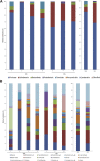Influence of Panax ginseng on obesity and gut microbiota in obese middle-aged Korean women
- PMID: 24748834
- PMCID: PMC3986624
- DOI: 10.1016/j.jgr.2013.12.004
Influence of Panax ginseng on obesity and gut microbiota in obese middle-aged Korean women
Abstract
Background: Gut microbiota is regarded as one of the major factors involved in the control of body weight. The antiobesity effects of ginseng and its main constituents have been demonstrated, but the effects on gut microbiota are still unknown.
Methods: To investigate the effect of ginseng on gut microbiota, 10 obese middle-aged Korean women took Panax ginseng extracts for 8 wk and assessment of body composition parameters, metabolic biomarkers, and gut microbiota composition was performed using 16S rRNA gene-based pyrosequencing at baseline and at 8 wk. Significant changes were observed in body weight and body mass index; however, slight changes were observed in gut microbiota. We divided the participants into two groups, the effective and the ineffective weight loss groups, depending on weight loss effect, in order to determine whether the antiobesity effect was influenced by the composition of gut microbiota, and the composition of gut microbiota was compared between the two groups.
Results: Prior to ginseng intake, significant differences of gut microbiota were observed between both at phyla and genera and the gut microbiota of the effective and ineffective weight loss groups was segregated on a principal coordinate analysis plot.
Conclusion: Results of this study indicate that ginseng exerted a weight loss effect and slight effects on gut microbiota in all participants. In addition, its antiobesity effects differed depending on the composition of gut microbiota prior to ginseng intake.
Keywords: Panax ginseng; gut microbiota; obesity; pyrosequencing.
Figures







 , the community of EWG in the prior to ginseng intake;
, the community of EWG in the prior to ginseng intake;  , that of EWG in the after ginseng intake,
, that of EWG in the after ginseng intake,  , that of IWG in the prior to ginseng intake;
, that of IWG in the prior to ginseng intake;  , that of IWG in the after ginseng intake. Unbroken circles indicate grouping of the communities in the prior to ginseng intake and broken circles indicate that in the after ginseng intake.
, that of IWG in the after ginseng intake. Unbroken circles indicate grouping of the communities in the prior to ginseng intake and broken circles indicate that in the after ginseng intake.Similar articles
-
Gut Microbiome Prolongs an Inhibitory Effect of Korean Red Ginseng on High-Fat-Diet-Induced Mouse Obesity.Nutrients. 2021 Mar 12;13(3):926. doi: 10.3390/nu13030926. Nutrients. 2021. PMID: 33809267 Free PMC article.
-
Stronger anti-obesity effect of white ginseng over red ginseng and the potential mechanisms involving chemically structural/compositional specificity to gut microbiota.Phytomedicine. 2020 Aug;74:152761. doi: 10.1016/j.phymed.2018.11.021. Epub 2018 Nov 19. Phytomedicine. 2020. PMID: 31005370
-
Comprehensive fecal metabolomics and gut microbiota for the evaluation of the mechanism of Panax Ginseng in the treatment of Qi-deficiency liver cancer.J Ethnopharmacol. 2022 Jun 28;292:115222. doi: 10.1016/j.jep.2022.115222. Epub 2022 Mar 24. J Ethnopharmacol. 2022. PMID: 35341933
-
Prebiotic effects: metabolic and health benefits.Br J Nutr. 2010 Aug;104 Suppl 2:S1-63. doi: 10.1017/S0007114510003363. Br J Nutr. 2010. PMID: 20920376 Review.
-
Ginseng and obesity: observations and understanding in cultured cells, animals and humans.J Nutr Biochem. 2017 Jun;44:1-10. doi: 10.1016/j.jnutbio.2016.11.010. Epub 2016 Nov 23. J Nutr Biochem. 2017. PMID: 27930947 Review.
Cited by
-
Ginseng as a therapeutic target to alleviate gut and brain diseases via microbiome regulation.J Ginseng Res. 2025 Jan;49(1):12-21. doi: 10.1016/j.jgr.2024.04.005. Epub 2024 Apr 27. J Ginseng Res. 2025. PMID: 39872288 Free PMC article. Review.
-
A Panax quinquefolius-Based Preparation Prevents the Impact of 5-FU on Activity/Exploration Behaviors and Not on Cognitive Functions Mitigating Gut Microbiota and Inflammation in Mice.Cancers (Basel). 2022 Sep 10;14(18):4403. doi: 10.3390/cancers14184403. Cancers (Basel). 2022. PMID: 36139563 Free PMC article.
-
Red ginseng extract blocks histamine-dependent itch by inhibition of H1R/TRPV1 pathway in sensory neurons.J Ginseng Res. 2015 Jul;39(3):257-64. doi: 10.1016/j.jgr.2015.01.004. Epub 2015 Jan 22. J Ginseng Res. 2015. PMID: 26199558 Free PMC article.
-
Nutraceuticals and Herbal Food Supplements for Weight Loss: Is There a Prebiotic Role in the Mechanism of Action?Microorganisms. 2021 Nov 25;9(12):2427. doi: 10.3390/microorganisms9122427. Microorganisms. 2021. PMID: 34946029 Free PMC article. Review.
-
Ginseng and obesity.J Ginseng Res. 2018 Jan;42(1):1-8. doi: 10.1016/j.jgr.2016.12.005. Epub 2017 Jan 10. J Ginseng Res. 2018. PMID: 29348715 Free PMC article. Review.
References
-
- Li C.P., Li R.C. An introductory note to ginseng. Am J Chin Med. 1973;1:249–261. - PubMed
-
- Joh E.H., Lee I.A., Jung I.H., Kim D.H. Ginsenoside Rb1 and its metabolite compound K inhibit IRAK-1 activation—the key step of inflammation. Biochem Pharmacol. 2011;2:278–286. - PubMed
-
- Choo M.K., Sakurai H., Kim D.H., Saiki I. A ginseng saponin metabolite suppresses tumor necrosis factor-alpha-promoted metastasis by suppressing nuclear factor-kappaB signaling in murine colon cancer cells. Oncol Rep. 2008;9:595–600. - PubMed
LinkOut - more resources
Full Text Sources
Other Literature Sources

